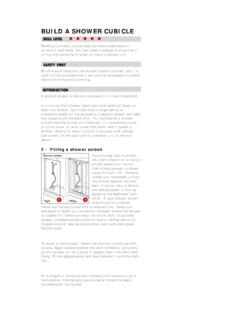Transcription of WATERPROOF YOUR ROOF - Wood Tools
1 WATERPROOF your roof If you are scared of heights don't attempt to repair your roof . If, however, you are confident at working from ladders and lightweight scaffolding towers, then the jobs described here aren't difficult. Ladders or scaffolding must be tied into the building and placed on firm ground. Get someone to support the bottom until you have tied the top. Use a ladder stay to give a good point of contact with the building. Warn everyone that you will be working on the roof , and erect barriers to keep people away. Anyone working below should have a hard hat.
2 Leaking roofs can damage the interior of your home. Fortunately there are lots of user-friendly products which willhelp to keep the weather out. Repairing leaks in roofs is normally the easy part. Finding out exactly where the leak is can be more difficult. Water can travel along the underside of beams and creep between close-fitting layers of roofing material, so the damp patch won't always appear directly below the leak. Eliminate all thepossible causes one by one, rather than jumping to conclusions. 2 - Detecting leaks The most difficult place to detect leaks is on a flat roof .
3 Often, the only answer is to completely coat the roof with a waterproofing solution. On pitched roofs the job of detection should be easier since you can identify slipped slates and tiles from the outside. Remove and replace broken tiles by carefully lifting them clear of the nibs on which they rest. It can sometime help to insert wooden wedges under the overlapping tiles first (1). Use a pair of binoculars to inspect your roof every year. Leaks around chimney stacks are notoriously difficult to diagnose. The most obvious cause is rain coming in from the top, or leaking flashings letting rain in around the sides.
4 However, this might not turn out to be the case. Often the cause of the damp is condensation within the flue. By the time this is discovered, a great deal of time, effort and money might have been wasted sealing the flashing and capping the pots. 3 - Condensation the house (which travels through , Flat roofs must have enough ree isused chimneys must be ventilated with an air inlet at the cold spot often found in the corner of bedrooms with ht ne cure for condensation is to remove airborne moisture - Flat felt roofing vel. The water should run away uddles and low spots the water collects on one part of the roof it is likely to leak f moisture vapour from Iceilings) is trapped in an unventilated space it will cause dampness through condensation.
5 This can happen in loftsdisused chimneys or above the ceilings in flat roofs. ventilation to keep the space above the insulation and below the WATERPROOF felt fof airborne moisture (2). Ifmoisture builds up it will cause damp patches on the ceiling and blisters in the roofing felt. Dbottom and an outlet at the top. If this isn't done airborne moisture from the house will find its way into the chimney and condense on the colder inside. This results in damp andsoot being drawn through the brickwork to form damp patches on the chimney breast. Asloping ceilings, is due to the loft insulation being pulledback to keep the loft ventilated.
6 In some cases, there migbe no insulation at all in the short sloping part of the ceiling, which means it is a natural place for condensation to form. Othrough better ventilation using extractor fans or a dehumidifier. 4 lat roofs should never be leFquickly. P If through. If you can't fill the low spots with trowelling-grade mastic, or build it up with two or three layers of felt, create a small section of new roof over the old one. Use a sheet of polystyrene stuck to the existing felt with bitumen. Cover the top of the felt with plywood and lay felt over the Make sure the felt is long enough to run down the plywood.
7 Sides and at least 150mm (6in) onto the roof . Stick the felt onto the existing roof with cold-lay adhesive or hot mastic to create a watertight seal. Blisters you have small blisters on a flat roof that aren't leaking, our best option is to leave them alone and use a solar- C t back the felt with four diagonal lines to create hesive and lay the cut Tack the flaps with galvanized felt nails, clout has r 5 - Repair tape Ifyreflective coating to keep the surface cool during the summer. If the felt has broken or looks like it might soonbreak, then it must be repaired. uenvelope flaps.
8 Gently peel back the felt and expose theunderlayer of roof decking (3). Apply a generous coating offelt adedges into the adhesive, squeezing out any excess. otherwise known as nails. When this layer dried, apply more adhesiveand stick a patch of felt ovethe top so it overlaps the repair by 150mm (6in) on all sides (4). To help it stick down, place some slabs on it for a few days. Flashing and joins to vertical upstands can be covered by flashing repair tape. Be sure to apply enough pressure when pressing it in place in order to get rid of any trapped air underneath (5). 6 - Stopping heat damaging felt Dark-coloured felt will attract a great deal of heat in the summer and if the flat roof has insulation underneath, the temperature can only escape upwards.
9 To counteract this white stone chippings are often used to reflect the sun. The problem with chippings however, is that if anyone walks on the roof , the chippings can get pressed through the felt and can cause leaks. Another wof protecting the felt is to use solar-reflective paint which is made specifically for this purpose (6). ay The paint can be applied by brush or roller in a single coat. Any flat roof regardless of whether it leaks or not, will have its life extended by the application of solar-reflective paint. 7 - Applying waterproofer Waterproofers come as water-based emulsions for use in fine weather and solvent-based paints, which are suitable foruse in the winter months, or when it looks like it's going to rain before the coating is dry.
10 Before applying waterproofer clear all traces of algae and moss off the roof using a fungicide and moss killer. It can take several days to kill off the roots. Brush the roof with a stiff broom and apply the first coat of waterproofer. If you are applying a bitumen emulsion, it is best to dip the brush in water from time to time to improve the flow. When the first coat is dry, apply a second coat in the opposite direction. 8 - Laying new felt If you are re-felting part of your home use a high-performance polyester felt. If you are felting a shed or garage you can use cheaper traditional felts.













